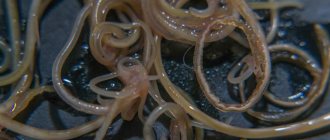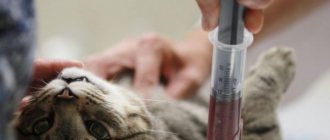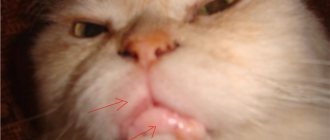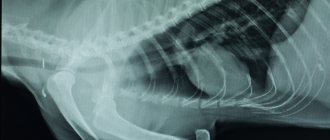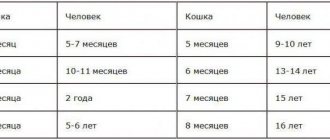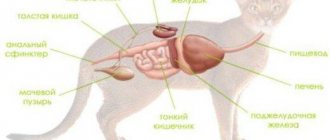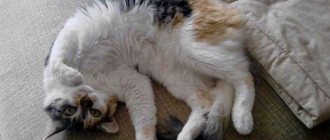Anemia in cats is a serious pathological condition in which the level of hemoglobin in the blood decreases, the number of circulating mature red blood cells, or a decrease in both indicators at once. For cats, this condition is particularly dangerous due to its rapid progression.
This is due to the fact that the period of restoration of the number of red blood cells in them is several times higher than the period of their life itself, i.e. self-healing requires a lot of time, which simply does not exist with the massive death of red blood cells. Externally, a deterioration in health due to anemia is noted by the owners almost immediately.
Red blood cells, with the help of hemoglobin in their composition, transport oxygen throughout the body. Consequently, with a lack of this protein or the red cells themselves, the body begins to experience oxygen starvation, manifesting all this with corresponding symptoms.
Main symptoms of the condition
What usually catches your eye:
- excessive lethargy and apathy of the cat to what is happening around. The animal sleeps almost constantly, is not interested in games, and reluctantly responds to a nickname;
- visible mucous membranes turn pale to a bluish tint, the limbs and tips of the ears become cold;
- if the anemia is of infectious origin (hemolytic), the mucous membranes may become yellow. Usually, with jaundice, the pet’s condition worsens sharply;
- the pulse quickens (tachycardia), the heart tries to compensate for the lack of blood in the body by pumping it rapidly through the vessels - heart failure develops;
- blood may be found in urine and stool;
- Appetite may be distorted due to a lack of minerals in the body (pica - eating inedible objects), or may disappear completely. Body weight is noticeably reduced;
- shortness of breath appears, the cat begins to breathe as if it does not have enough oxygen (in fact, it does) - a sign of pulmonary failure;
- body temperature usually decreases;
- kittens in a litter with anemia are significantly slower in growth than their counterparts and gain little weight;
- Indigestion may occur, both in the direction of loose stool and in the direction of constipation;
- weak filling of pulse pressure in the blood vessels.
Anemia in cats has general, nonspecific symptoms, so very often the diagnosis is made incorrectly. This is why it is so important to take a blood test for the listed manifestations. It is impossible to determine anemia by eye with 100% accuracy!
Symptoms
Lack of appetite, sudden weight loss, lethargy, lethargy of the pet, and low mobility are common signs of the disease that should alert the owner of the animal. An anemic condition is indicated by one or more characteristic symptoms that signal a lack of oxygen in the blood:
- pallor, bluish tint of the mucous membranes of the mouth and all non-pigmented areas of the skin;
- increased heart rate, shortness of breath when moving, difficulty breathing at rest;
- excessive sleepiness;
- low pressure.
The type of disease cannot be determined independently, but a number of indirect, not always manifested, symptoms can indicate the root cause and type of the condition:
- pallor, bleeding, pinpoint hemorrhages of the oral mucosa with possible hemoptysis are symptoms of aplastic anemia.
- autoimmune hemolytic anemia is characterized by difficulty breathing, drowsiness, possible loss of consciousness, diarrhea and vomiting, lack of appetite, unnatural thirst;
- an infectious type of disease (hemobartenellosis) notes yellowness of the mucous membranes due to increased load on the biliary tract, dark urine, colored with bile pigment or red with hemoglobin (hemoglobinuria).
Classification of anemia in cats
The following types of anemia are distinguished in cats:
- According to the method of self-healing and the level of bone marrow function, there are: non-regenerative, when more red blood cells are destroyed than the body can produce in return, i.e. no compensation occurs, the condition quickly deteriorates;
- regenerative, when there is intensive production of red blood cells to replace destroyed ones, the bone marrow does its best to compensate for the condition.
- The posthemorrhagic form develops against the background of extensive blood loss, when the volume of circulating blood in the body sharply decreases. It can be acute (against the background of immediate massive bleeding) and chronic (with small bleeding, but for a long time). The acute form is more dangerous due to the inability to quickly replenish the volume of circulating blood.
Types of anemia
Despite the fact that all types of anemia give a similar clinical and hematological picture, it is customary to distinguish several types of this disease. Let's look at each of them in more detail.
Hemolytic anemia
The cause of this type of disease is a genetic factor, poisoning, intoxication or parasitic damage to the circulatory system.
Distinctive features of hemolytic anemia are:
- The mucous membranes become not just pale, they acquire a jaundiced tint.
- There is an enlargement of the spleen.
- Hemoglobin cells enter the urine, causing it to turn bright red.
- A blood test reports an increase in the leukocyte sedimentation rate, an increase in the number of immature red blood cells, while the total number of red blood cells is below normal.
Posthemorrhagic anemia
This type of anemia develops due to large blood loss as a result of external or internal bleeding. Cat owners may mistakenly believe that bleeding occurs only when there is some kind of injury. However, blood loss can be caused by infectious diseases or infestations. In veterinary practice, there have been cases where helminthic infection reached such proportions that the parasites literally tore the walls of blood vessels. As a result of such damage, the cat may suffer from hidden internal bleeding for a long time, without the owners even knowing about it.
With posthemorrhagic anemia, the following symptomatic picture occurs:
- The sick cat's pulse is weakened. Blood pressure is low, which causes depression; in severe cases, the animal may faint.
- Involuntary urination is observed; even a toilet-trained animal may begin to walk under itself.
- Heart rate slows down.
You might be interested in: Anatomy and physiology of a cat: main characteristics
Even from the description of the symptoms, it is clear that this condition threatens the animal with serious complications. Cats receiving anthelmintic drugs for preventive purposes are protected from the occurrence of anemia of a parasitic nature. Anti-parasitic measures should be carried out every three to four months.
Hypoplastic anemia
The impetus for the development of this disease is unfavorable external factors. The disease can be caused by a poor diet that does not meet the body's need for vitamins and minerals.
There are two types of hypoplastic anemia:
- Myelotoxic, caused by a disorder in the hematopoietic system as a result of poisoning by toxins, it is quite rare. The catalytic converter that causes failure is prolonged contact with heavy metal salts.
- Deficiency, developing due to a lack of protein, copper, iron and vitamins, is diagnosed much more often.
Aplastic anemia
This type of anemia is similar to the hypoplastic type. Aplastic anemia develops in an animal that has been poisoned by potent drugs, rodenticides, or radiation. It is not possible to determine this type of anemia on your own. She has no characteristic symptoms. The animal's health is deteriorating, every day it gets worse and worse. A lesion can only be identified through a comprehensive diagnosis.
Infectious anemia
The disease is also known under another name – hemobartonellosis. The causative agent of the disease is Eperitrosoon (a microorganism belonging to the Bortonella group). The wand behaves like a parasite, destroying them. This type of anemia is typical only for felines. The parasite is spread by fleas and other insects; infection occurs through a bite.
Infectious anemia manifests itself in the form of the following symptoms:
- the animal begins to rapidly lose weight;
- the spleen and lymph nodes increase in size;
- the cat refuses to eat and becomes passive;
- the temperature does not rise.
Nutritional anemia
Like hypoplastic anemia, nutritional anemia is the result of poor nutrition. However, there are also differences. In the case of the alimentary species, a decrease in hemoglobin levels is associated not only with a poor diet, but also with its consequences, which have a negative impact on the functioning of the gastrointestinal tract. The content of pepsins or hydrochloric acid in the gastric secretion is reduced, which, in turn, causes poor absorption of food. All these factors become the basis for the occurrence of anemia.
Young individuals and kittens are susceptible to the disease. It shows up quite clearly:
- The cat looks exhausted, the fur becomes dull and matted.
- Kittens develop with a delay.
- Breathing is shallow, it is clearly visible on the sides of the animal.
- The animal becomes apathetic, does not want to play, and loses its appetite.
Therapy
Schemes of how and how to treat a cat for anemia are developed and prescribed only by a specialist. Due to the numerous causes of the condition, alas, there is no magical universal cure for anemia, after taking which everything will immediately return to normal. You need to understand that some time will still be spent on rehabilitation.
Treatment of anemia is always comprehensive and necessarily includes identifying the primary cause of the pathology. There is no point, for example, in intensively pumping a cat with iron-containing drugs if it has congenital bone marrow pathologies or blood parasitic lesions.
- Replacement therapy is mandatory for extensive blood loss. Cats can drip:
- glucose 5%, saline, Ringer-Locke/Ringer's solution;
- perftoran (“blue blood”), rheopolyglucin or polyglucin.
Replacement therapy with packed red blood cells and blood transfusions is almost never used in cats.
The type of solution and the volumes administered depend on the severity of the condition, the cat’s body weight and are calculated by the veterinarian individually in this particular case. In some situations, subcutaneous droppers can be used, because Cats are not always able to do this intravenously.
- The use of active antiviral or antibacterial therapy in the treatment of anemia in cats, depending on what caused the primary disease.
- Administration of vikasol ( vitamin K ) intramuscularly (1-2 mg/kg), as well as calcium chloride 10% intravenously (3-10 ml/animal) - increases the clotting properties of blood and reduces the permeability of blood vessels. In case of severe bleeding, an injection of 0.1% adrenaline (0.05-0.3 ml) is allowed.
- If neonatal isoerythrolysis is determined, then the kittens must be weaned from breastfeeding and artificially fed (how to independently feed kittens after weaning can be found here).
- The use of specific antiparasitic drugs if anemia is caused by blood parasites.
- Parallel symptomatic treatment of internal pathologies that have developed during oxygen starvation, but with strict adherence to drug compatibility. Treatment priorities are set only by a specialist.
- If anemia is caused by internal helminths and fleas, unscheduled treatment against ectoparasites and deworming is mandatory. It is worth opting for drugs that will not put additional stress on the liver and kidneys (according to the recommendations of the veterinarian).
- Specific iron supplements for cats:
- Suiferrovit A : 2 times a week intramuscularly in a dose of 0.5-5 ml (depending on the weight of the cat and the severity of the condition) for a course duration of 2-4 weeks;
- Ferran : once in a dose of 1-2 ml intramuscularly. If necessary, the injection is repeated after 10-12 days;
- Bio-iron : orally with food or drink, 0.5 ml for every 5 kg for 2-3 weeks;
- Ferroglucin 75 : once at a dose of 50 mg/kg (in 1 ml of solution 75 mg of active substance), repeat after 10 days if the situation requires it;
- Ferridextran 10%: intramuscularly once 1-2 ml per animal;
- Ferrodex : deep into the muscle, 1-2 ml per cat once;
- Gemovet : ½ tablet for every 5 kg of weight once a day for a month. Repeat the course if necessary after a blood test.
It is forbidden to take iron-containing drugs for infectious, toxic and parasitic anemia, because Each new portion of iron will worsen the cat’s condition by improving the living conditions of viruses, bacteria and protozoa, and also bind to toxins, turning into harmful compounds.
All iron-containing preparations are administered to cats according to strict indications and under the direct supervision of a veterinary specialist! The point is the specificity of the drugs, the numerous contraindications and the unpredictability of the body's reaction to them.
- Fight and treatment of chronic pathologies of the kidneys and liver. For example, with renal failure, anemia very often develops, which cannot be eliminated without normalizing the functioning of the cat’s kidneys. And vice versa - the condition of the kidneys worsens against the background of the constant removal of destroyed red blood cells.
- If the cause of anemia is more serious than toxic poisoning, then detoxification therapy is mandatory, including the mandatory use of corticosteroids and glucocorticoids (prednisolone, dexamethasone, etc.). Corticosteroids are also needed for autoimmune anemia.
- You definitely need to balance and adjust your diet. How to feed a cat with anemia? Be sure to include raw liver (preferably beef) into your diet! The offal should be purchased from trusted producers or after home slaughter after veterinary examination to eliminate the risks of additional infection with helminths. If it is not possible to give raw liver, you can purchase liquid liver extract in capsules at a veterinary pharmacy. Give strictly according to the instructions, without exceeding the dosage.
It is also recommended that cats be given wheat greens, an herb often sold in pet stores. It contains chlorophyll, which intensely saturates the blood with oxygen by increasing hemoglobin.
In addition to additional feed additives, the entire diet should be varied and with an emphasis on meat products (chicken, beef, turkey) and proteins (eggs, fish, cottage cheese). It’s good if your diet contains fermented milk products, which stimulate normal intestinal function.
- It is necessary to introduce vitamin and mineral preparations that stimulate hematopoiesis (production of red blood cells) and improve the absorption of iron not only from feed, but also from drugs (if any are present in the treatment regimen):
- intramuscular cyanocobalamin (vitamin B12) : 250 mcg per cat weighing up to 5 kg once a day intramuscularly or into a vein (if, for example, there is an intravenous catheter) for a course of at least 2 weeks;
- subcutaneously, intravenously, intramuscularly Gamavit : 0.3-0.5 ml/kg 1-3 times a week for a month;
- orally or injected folic acid (vitamin B9) : 1-2 mg/kg orally for 2-3 weeks;
- subcutaneously or into the muscle Vitam (intensive complex of all essential vitamins and amino acids): subcutaneously or intramuscularly 0.3-0.5 ml/kg twice a day or once 0.6-1 ml/kg. In special cases, the dosage may be exceeded by 10 times.
- Very rarely, and in most cases more experimentally, they resort to blood transfusions or bone marrow transplants.
Prognosis for recovery: depends on the cause that led to anemia. In most cases, when the hematopoietic organs are not affected, it is favorable, and the pathology is successfully eliminated. In case of autoimmune anemia, viral, cancer or toxic, always be careful.
Diagnostics - what tests will determine anemia?
Clinical blood test:
- Anemia is diagnosed when a low hematocrit or total red blood cell volume is detected.
- count the number of reticulocytes and describe the anemia as regenerative or non-regenerative. Regenerative anemias usually consist of macrocytic, hypochromic red blood cells with marked polychromasia.
- pay attention to the morphology of red blood cells and identify schistocytes (which suggest the presence of DIC, hemangiosarcoma) and spherocytes (which suggest immune-mediated hemolytic anemia). Describe the size of red blood cells and chromogenicity.
- determine the level of total protein (normal or reduced). A decrease in total protein levels along with anemia indicates blood loss.
Flowchart for determining anemia in pets
Features of the study for non-regenerative anemia
- Blood test for the presence of intracellular parasites that cause hemolysis.
- Bone marrow: Erythroid progenitors are examined to determine erythroid aplasia. Determine the presence of tumors or immune-mediated erythroid destruction.
- Biochemical/T4 test: helps identify kidney failure, hypothyroidism, Addison's disease or other chronic diseases.
- ANA (antinuclear antibodies): To determine the presence of immune-mediated diseases such as systemic lupus erythematosus, autoantibodies to nuclear antigens (ANA) are tested.
Features of diagnosing regenerative (hemorrhagic and hemolytic) anemia
- The level of total protein is determined. Low total protein levels indicate blood loss. A normal total protein level indicates hemolytic anemia. Hemolytic anemia can be immune-mediated or non-immune-mediated.
- History can provide key information about the cause of anemia.
- Zinc poisoning: Has your pet ingested foreign objects, such as coins or other metal objects?
- Onion poisoning: has the animal eaten onions in any form? Onions promote the appearance of Heinz bodies.
- Tylenol: Is your cat injected with Tylenol? The drug causes excessive formation of Heinz bodies.
- Does the animal have a history of immune-mediated disease?
- Drugs: Is the animal being given any drugs (eg sulfonamides)?
- Ticks: Some of them are carriers of rickettsial and ehrlichiosis diseases.
- FIV: Is the animal F1V/FeLV positive? Hemobartenellosis is most common in FIV/FeLV positive cats.
- The morphology of red blood cells is determined. Heinz Taurus indicates a violation of oxygenation processes (for example, in onion poisoning).
- Schistocytes (fragments of red blood cells) indicate disseminated intravascular coagulation syndrome or hemangiosarcoma.
- Spherocytes indicate immune-mediated hemolytic anemia.
- Parasites in red blood cells can cause hemolysis I (Erlichia, Babesia, Hemobartonella, Rickettsia).
The main reasons for the development of the pathological condition
There are many reasons leading to anemia in cats:
- extensive bleeding (internal or external), leading to loss of total blood volumes;
- anemia in chronic infections (renal failure - anemia in a cat with chronic renal failure);
- conditions accompanied by hemolysis (destruction) of red blood cells - often with severe poisoning by toxic substances, heavy metals, etc.;
- unbalanced diet, metabolic disorders or disruption of the gastrointestinal tract, when the body receives insufficient amounts of B vitamins and iron;
- endocrine diseases;
- parasitic lesions (helminths, blood-sucking insects, protozoa (pyroplasmosis));
- viral anemias that occur with damage to organs and the process of hematopoiesis (leukemia, feline viral (infectious) peritonitis, panleukopenia);
- autoimmune hemolytic pathologies (for example, neonatal isoerythrolysis - a condition that occurs in small kittens when their blood groups differ from their mother - against this background, when feeding on breast milk, maternal antibodies that enter the baby's body begin to attack and destroy their red blood cells);
- hemobartonellosis is a specific infectious anemia of cats provoked by mycoplasma Haemofelis;
- intoxication with certain medications or foods (paracetamol, garlic, onions);
- breed predisposition to the destruction of red blood cells due to any internal or infectious pathology (Abyssinian, Somali cats suffer from congenital instability of red blood cells);
- oncology (progressive malignant tumors produce toxins that have a hemolytic effect on blood cells).
First signs of illness
The symptoms of anemia in cats are not clinical, that is, they cannot be used to make this particular diagnosis, although treatment is always necessary and desirable - the sooner the better. Cells of the brain and heart muscle begin to react to the lack of oxygen and nutrients first, which causes the first signs of anemia to appear:
- Animals gradually become lethargic, weak, get tired quickly and do not show their former interest in games.
- The mucous membranes of the oral and nasal cavities, as well as the palate, become grayish-bluish, which is clearly noticeable in light-colored animals.
- An increased heart rate is observed.
- Periods of shortness of breath gradually appear and intensify, regardless of physical activity. The animal may begin to choke while sleeping.
- Loss of appetite.
- The animal is quickly losing weight.
If anemia is not treated, death may occur spontaneously in a cat or cat, without any preliminary nuances, most often at night.
It must be remembered that anemia in cats is essentially only an additional condition, so to speak - a symptom, of some underlying disease. Anemia itself never develops, except for obvious signs of blood loss.
The lecture is given by Svetlana Shishkanova, veterinarian, head of the independent veterinary laboratory “POISK”, St. Petersburg.
What do blood tests show?
If any several symptoms of anemia appear, you should definitely take a blood test. What the metrics specialist will see:
- a sharp decrease in hemoglobin levels;
- decrease in the number of red blood cells with normal hemoglobin levels;
- decrease in the number of red blood cells and hemoglobin;
- a drop in hematocrit level and a decrease in color index.
Based on hemoglobin content, anemia is classified into:
- normochromic (color index is approximately within 1, hemoglobin is normal, red blood cells are low);
- hyperchromic (a sharp increase in hemoglobin, red blood cells are low, as well as many immature cells or reticulocytes - this form is practically not recorded in cats);
- hypochromic (color index below 1, low level of both hemoglobin and red blood cells, and the drop in hemoglobin is more pronounced). This includes all iron deficiency anemia.
A decrease in hematocrit of less than 30% (the percentage of red blood cells to the total volume of blood plasma) also indicates anemia.
Why is anemia dangerous for a cat?
The function of red blood cells in the body is associated with the transport of oxygen to organs and tissues.
Its molecules are transported using a specific protein - hemoglobin, which contains iron atoms. It is this microelement that causes the red color of blood. Without oxygen molecules, not a single biochemical reaction can take place in a living organism. Normally, in a physiologically healthy cat, the hemoglobin concentration in the blood ranges from 80 to 150 g/l. This is the amount of iron-containing protein that can provide the body’s tissues with the necessary oxygen.
Red blood cells are also directly involved in the mechanism of supplying the body with oxygen. A healthy cat should contain at least 5.10*1012/l red blood cells.
Normal blood counts in a cat
When the level of hemoglobin and the number of red blood cells decrease, the animal begins to experience hypoxia (oxygen starvation). Tissues and organs do not receive enough oxygen, and redox reactions and cellular respiration are disrupted. The acid-base balance is disturbed, and the body experiences signs of intoxication.
Oxygen deficiency leads to dysfunction of the cardiovascular system and negatively affects immune structures. The animal quickly loses weight and becomes lethargic. A weakened body is a target for infectious and non-infectious diseases.
Prevention of anemia
The onset of anemia can be prevented. For this it is enough:
- promptly vaccinate your cat against dangerous viral infections;
- be sure to treat once a quarter for helminths and, as necessary, for fleas;
- do not delay the treatment of any diseases associated with the process of hematopoiesis and accompanied by bleeding;
- try to regularly monitor the functioning of the kidneys and liver system;
- feeding should be complete, varied and balanced;
- do not ignore taking vitamin-mineral complexes if the situation requires it or there is a veterinarian’s prescription;
- if possible, exclude all possible contacts with toxic substances that can cause severe intoxication with the destruction of red blood cells.
Author:
Grinchuk Ekaterina Andreevna veterinarian
Diseases associated with feline leukemia virus.
Lymphosarcoma is the most common type of malignant tumor in cats. The disease is always fatal and causes death in adult animals. There are several distinct forms of lymphosarcoma. There are four main types of lymphoid neoplasms: thymic lymphosarcoma, multiple lymphosarcoma, alimentary lymphosarcoma and lymphocytic leukemia.
Lymphosarcoma of the thymus (thymus) - with this form, large tumor masses are observed in the anterior mediastinum. The lymph nodes of the chest always increase in size, but the spread of tumor cells to other nodes is extremely rare. Also, tumor cells are almost never found in the blood.
Clinical signs:
The tumor may develop over several weeks or months. It becomes quite large before any clinical signs appear. As a result of the tumor's pressure on the lungs and trachea, rapid breathing, shortness of breath, and exercise intolerance occur. Heart sounds become muffled. If the tumor compresses the esophagus, it becomes difficult to swallow.
Diagnosis is made mainly on the basis of clinical signs. It is also known that this disease is more common in young cats, with an average age of 2.5 years.
An X-ray examination of the chest will reveal tissue proliferation in the anterior mediastinum, displacement of the trachea, and the presence of pleural fluid. Pleural fluid cytology will reveal malignant lymphoid cells. A peripheral blood smear is taken, although hematological examination does not always reveal tumor cells. It is necessary to conduct a test for feline viral leukemia, since in 80% of cases with thymic lymphosarcoma the test is positive.


